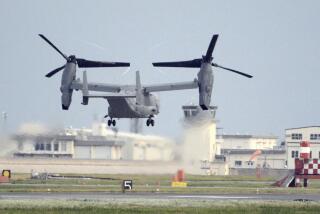Salvage Crews Turn Attention to 17 Objects on Ocean Floor
KENNEDY SPACE CENTER, Fla. — As currents slowly scattered wreckage from the space shuttle Challenger across a widening swath of the Atlantic Ocean, salvage crews on Monday turned their attention toward 17 unidentified objects resting on the seafloor north of here.
Three National Aeronautics and Space Administration vessels, each equipped with submersible camera devices to pan the ocean floor, were working 15 miles offshore where the space agency said “photographs and radar indicated that large objects hit the water after the . . . incident.”
NASA officials said Lockheed engineers familiar with the spacecraft were onboard, and that “further definition is being sought on about 17 potential targets.”
The Navy and Coast Guard, meanwhile, planned to start pulling ships off the search effort today, while more long-range airplanes were to be sent aloft to scan the seas for far-ranging wreckage.
In Washington, acting NASA Administrator William R. Graham, responding to reporters’ questions, acknowledged Monday that a portion of the crew’s cockpit had been retrieved but he refused to speculate about what it revealed.
Asked whether any human remains had been uncovered, he said, “All I can tell you at this point is that we are very sensitive to the issue of personal effects and to the remains of the astronauts.”
NASA officials also hope to recover sections of the shuttle’s right solid rocket booster. A fissure in the right booster rocket is believed likely to have played a major role in the disaster, and discovery of the proper pieces could unlock important evidence.
NASA’s in-house panel of senior officials established to conduct an investigation of the disaster met here Monday with an unspecified agenda and an uncertain future--as a result of President Reagan’s appointment of a “blue ribbon commission” to carry out a full investigation.
Although White House spokesman Larry Speakes indicated that NASA’s own panel would “cease to exist,” NASA officials said the group would continue to sift through evidence to present to the presidential commission.
NASA also reported Monday that underwater cameras have shown that the first two large objects detected by sonar turned out to have been a helicopter and light aircraft--and not parts of the shuttle.
More to Read
Sign up for Essential California
The most important California stories and recommendations in your inbox every morning.
You may occasionally receive promotional content from the Los Angeles Times.











